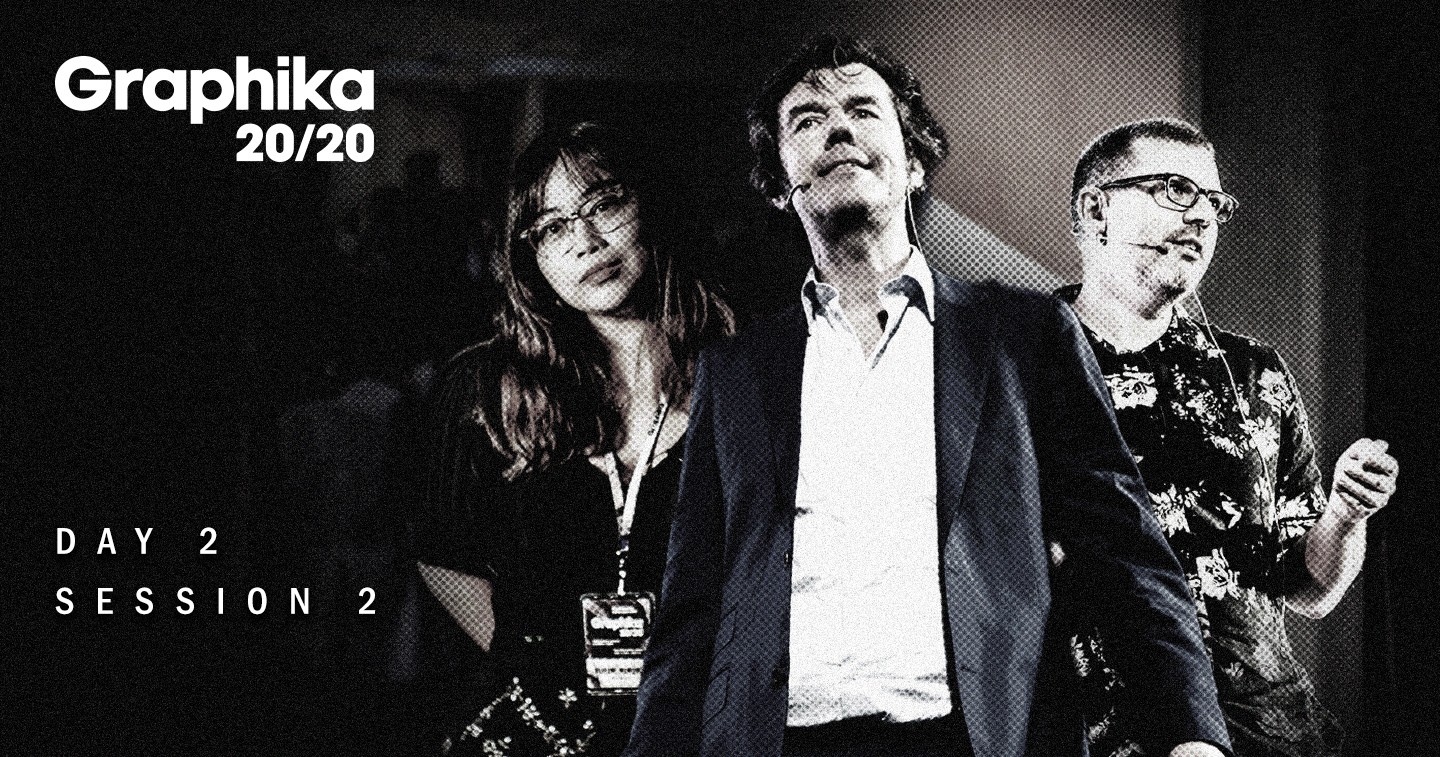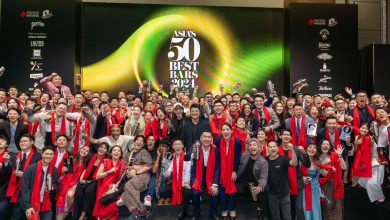MANILA, PHILIPPINES – Believe us when we tell you that to have been a witness at this year’s Graphika was such an experience. From the moment the two-day conference started, up until the very end, no minute was wasted not learning new things from their esteemed lineup of guest speakers. I personally think it was a two-way street – while the audiences absorbed the knowledge shared to them, the speakers themselves also fed into the energy everyone else in the convention center was giving.
The speakers for Session Two of Day Two – Raxenne Maniquiz of Plus 63 Design Co., FutureDeluxe’s James Callahan, and the highly-revered Stefan Sagmeister – were all fitting conclusions to one of the country’s biggest conferences on creativity. And just like in the previous sessions, all three speakers each had their own main points that they discussed. Maniquiz talked about the Balancing Act of her multi-faceted career, Callahan dissected what it means to create work with the future in mind, and Sagmeister shared with us what beauty exactly is and why it matters in the real world.
Middle Ground
Raxenne Maniquiz is one of Plus 63 Design Co.’s rising stars. The company, which is part of a collective called Hydra Design Group, is made up of very talented creatives whose works have been gaining popularity in the country and abroad. They are also the people behind Graphika 2020’s visual identity and theme.
Maniquiz shared that she was initially taking as many projects as she could as long as she could do them. “When I started freelancing, I just really wanted extra cash. but I was accepting projects as long as it was something that I can do.” Eventually, this led her to more complex projects and helped her land bigger clients eventually.
"Doing these crafts for years enabled me to hone my craft and push myself further. I feel like with every new project I do, I become better." – @raxenne Maniquiz on balancing her act between her day job and freelance. @GraphikaManila#Graphika2020 pic.twitter.com/CwWQbKFjaK
— adobo magazine (@adobomagazine) February 16, 2020
During her talk at Graphika 2020, she broke down the different steps, and showed how one work evolves from one iteration to the next as she deals with clients. “Sometimes there’s tension between client and creative, but it can all work out,” she shared, reiterating that sometimes you also have to trust your client.
She spoke about working with clients like Theo and Philo, where she demonstrated how certain changes suggested by her clients were initially met with doubt but turned out for the better in the end. She also described how she and her team played with the thought of UNIQLO expanding outside Metro Manila, and so creating a heart that represented the city with arteries and veins stretching out that described its expansion.
She eventually started working on other projects that included branding works, product design, shoes, and wedding invites.
“Doing these crafts for years enabled me to hone my craft and push myself further. I feel like with every new project I do, I become better,” she told the crowd at Graphika.
She teased the audience with a preview of a project she’s working on with Don Papa Rum, but also shares that she wants to work on botanical books and research in the future.
To end the talk, she encourages everyone to be persistent in mastering and exploring their craft. “I’d like to keep making good work. Better work. I don’t want to settle with what I have now.”
Process now, polish later
Exploring what else one can do with a creative output was also echoed by Future Deluxe Owner and Director James Callahan. At Graphika 2020, he showed the visually stunning work they have made in their company, and exactly how they came up with those ideas.
Future Deluxe, as you of course would have known already, is an agency that has pushed out amazing work for brands everyone is familiar with. They have worked with giants like Converse, Verizon, Apple, and so much more. They are also the ones who helped BBC rebrand and create jaw-dropping visuals for their launch.
"We design by doing. We make." – James Callagan gives an awestruck presentation on what they do at @futuredeluxe here at @GraphikaManila #Graphika2020 pic.twitter.com/ObTB8jWyak
— adobo magazine (@adobomagazine) February 16, 2020
Callahan talked about how they try to see things from a futuristic perspective, or at least a future-sensitive view, and finding technology to play with. In their work for Converse, for example, they went at great lengths to really recreate a shoe digitally, adding the tiniest details like hairs on the laces and the texture of the fabric. They would then break down the shoe apart, literally twist it, and basically change how the shoe would look.
He also touched on the structure of their company – that instead of having a vertical ladder or hierarchy, they prefer to process things in a horizontal manner wherein every staff member has a voice and an avenue to share their own ideas. One cohesive team. One team. One dream. But they also, of course, work closely with the client.
“We play with the logo. We break things apart. We come at it in a very different angle. And we share this constantly with brands just to get their juices flowing,” Callahan shared. He also spoke about how important it is to really dive into the work. “Ten percent of our time is pure R&D. We work on projects that our team want to work on. They are personal projects.”
Lastly, a bit of advice if you want to get in Future Deluxe someday: “We wanna see your personal work, not your client work. Show us the stuff you do in your free time, the stuff you enjoy making.”
The definition of beauty
Stefan Sagmeister – a highly regarded artist whose reputation precedes him, has worked with different medium over the years, and has produced art and designs that continues to captivate almost anyone – took the stage as this year’s final speaker for Grpahika 2020. He posed a challenge to everyone in the conference, asking them to think about what a beautiful piece of art is, and why beauty really matters.
He started his session by telling everyone that the worst thing to happen to the idea of beauty is the statement “Beauty is in the eye of the beholder”. He clarified by saying that if the statement was indeed true, and that beauty is purely subjective, then there is no need for designers to continue pursuing great work. “Why go through the unbelievable trouble that designers go through to make these works. It’s not true,” he shared.
He further explained his point by citing examples throughout history. Among those he tackled were the architectural feats displayed in the hallowed ruins in Lisbon. He said that the ruins still stand beautifully and were designed in a way that wasn’t purely utilitarian. Even the canons were adorned with patterns and reliefs. He joked, “If we were going to kill them, we might as well kill them with something beautiful. We’re not barbarians.”
It would be better to come in with good architecture than to come back and decide to paint the wall. – Stefan Sagmeister at @GraphikaManila #Graphika2020 pic.twitter.com/5nm4RORrcC
— adobo magazine (@adobomagazine) February 16, 2020
He then poses another question, asking the audience how modern architecture went from richly designed structures like gothic cathedrals and buildings to ones that have barely any form of beautiful design in them. He jokes about the Memphis Cook Convention Center, whose hometown has a rich musical history, as the manifestation of this kind of problem.
Sagmeister says that this was started by an Austrian architect named Adolf Loos who wrote the essay Ornament and Crime in the 1930s. His essay, which was turned into a book, was a criticism on beauty and design, and how these were unnecessary elements to creation. Loos wrote, “I will not subscribe to the argument that ornament increases the pleasure of the life of a cultivated person, or the argument which covers itself with the words: “But if the ornament is beautiful! …” To me, and to all the cultivated people, ornament does not increase the pleasures of life.”
The idea was to focus on function than form, which created an architectural movement. A number of buildings based were erected based on this principle in the ’70s, but the problem was that no one wanted to live in them, and so they were demolished in the ’90s. And even though beauty has proven to be an important aspect to design, many still subscribe to the belief that function can exist without proper form.
Loos’ ideas became, and still are, the basis for what an international standard is, which is why many buildings built in recent decades have been more focused on the economics of space rather than the power of design. Sagmeister jokes about this, saying: “International airports all look the same. But the one thing that we want to be consistent in them is what remains different – the electrical outlets.”
Sagmeister says that one thing that can be done in these situations is to then find ways to beautify, perhaps through painting over them. He shows an image of an underpass in New York that was barely used, but became an Instagram-worthy destination after they painted it.
He cited Bauhaus legend Max Bill: “It has become clear to us that beauty can no longer be developed out of function alone; instead, the demand for beauty has to be set on the same level as a functional demand, since it is a function too.”
Sagmeister further explains that in the context of minimalism or maximalism, saying that beauty is intentional: “I don’t think this is a question between simplicity and ornamental. not minimalism and maximalism. There are beautiful and ugly possibilities. The question here is between carelessness, and love and attention.”
He gives the audiences four things to help them in creating beautiful work:
- Recognize beauty
- Collect beautiful things
- Copy beauty to learn from it (not reproduce)
- Create beauty
“Beauty is deeply part of who we are. symmetry was present thousands of years ago. There are stones erected tens of feet high and there is no functionality. I made a thing, then I must be absolutely fabulous,” he further explained. “To say that beauty isn’t important is completely idiotic”.








